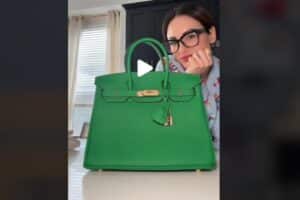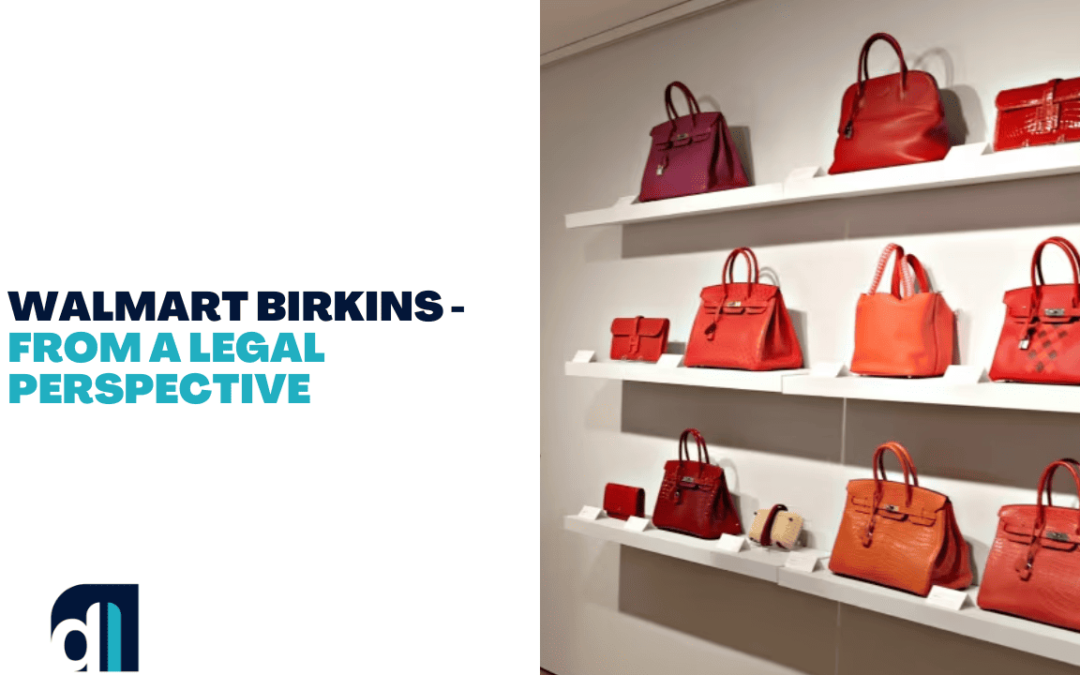The term “dupe” has become increasingly prevalent in the ever-evolving fashion landscape. It refers to products that closely resemble high-end items but are sold at a fraction of the price.
Unlike counterfeits, dupes do not bear the original brand’s name or logo, yet they mimic the design and aesthetic of luxury goods. This phenomenon has sparked debates over intellectual property rights, brand dilution, and consumer ethics.
A recent example that has garnered significant attention is the so-called “Walmart Birkin or Wirkin.” Priced between $60 and $299.98, these handbags bear a striking resemblance to the iconic Hermès Birkin bag. The latter is renowned for its exclusivity and can command prices over $500,000.
The Walmart version gained viral status, particularly on platforms like TikTok, where users showcased the bags as affordable alternatives to the luxury original.

A still from a TikTok video posted by @lifestyle.with_g on December 29, 2024, showcases the viral bag, dubbed the ‘Wirkin,’ a playful reference to Walmart Birkin or working-class Birkin, which was sold on Walmart’s website. (@lifestyle.with_g/TikTok)
This surge in popularity has ignited discussions about the legal implications of producing and selling such look-alike products. This blog dives into these legal aspects, examining the fine line between permissible imitation and unlawful infringement in the context of fashion law
Hermès’ Intellectual Property Rights
Trademark Rights
Hermès has established strong trademark protections for its Birkin bag, encompassing the product’s name and distinctive design.
- BIRKIN Word Mark (No. 2991927)
Registered on February 17, 2004, under serial number 78369087, this mark secures the exclusive use of the term “BIRKIN” for Hermès, preventing unauthorized use in commerce.
- Trade Dress Rights (USPTO Reg No. 3936105)
This trade dress protection, registered on March 29, 2011, under serial number 76700120, covers the unique visual appearance of the Birkin bag, including its shape, design, and overall aesthetic.
Trade Dress Protection
The Birkin bag’s design elements are safeguarded under trade dress law, which protects the overall look and feel of a product that signifies its source.
Protectable Design Element
- Shape and Profile: The bag features rectangular sides and a bottom with a dimpled triangular profile.
- Flap and Lobes: A rectangular flap with three protruding lobes, each containing keyhole-shaped openings around the base of the handles.
- Strap and Clasp: A horizontal rectangular strap with an opening to receive a padlock eye and a padlock clasp at the center of the strap.
Trade dress protection ensures that consumers can identify the source of a product based on its appearance, maintaining the brand’s reputation and consumer trust. It prevents competitors from imitating the product’s design, thereby preserving the brand’s unique market position and consumer loyalty.
Goodwill and Brand Equity
Trademarks and trade dress are vital in building and maintaining a brand’s goodwill and equity.
A strong trademark portfolio, including both word marks and trade dress, reinforces the brand’s identity and assures consumers of consistent quality.
Unauthorized imitations or products of inferior quality can dilute the brand’s image, leading to consumer confusion and potential loss of trust. Such infringements can erode the brand’s value, as consumers may associate the brand with lower-quality goods, diminishing its premium status.

Legal Framework Surrounding Dupes
The proliferation of counterfeit and imitation products frequently challenges the fashion industry. These products often mimic the appearance of established luxury items, leading to potential legal disputes.
A. Trademark Infringement
Trademark infringement occurs when a mark used by one party is likely to cause confusion among consumers regarding the source or sponsorship of goods or services.
Used to determine if trademark infringement has occurred, it is often called the “likelihood of confusion” test.
Analysis of Third-Party Sellers Using “Birkin” and “Hermès” as Descriptors
Third-party sellers listing products with descriptors like “Birkin” or “Hermès” may be infringing on the luxury brand’s trademarks. Even if these terms are used descriptively, infringement may be present if they cause consumer confusion or suggest an affiliation with the brand.
For instance, using “Birkin” in a product title without authorization can mislead consumers into believing the product is an authentic Hermès item.
Potential Defenses: Price Disparity and Disclaimers
Price Disparity: Defendants might argue that significant price differences between their products and the original brand’s items negate confusion. However, this defense is not always persuasive, as consumers may still be misled by the use of a brand’s name or likeness.
Disclaimers: Including disclaimers such as “not affiliated with Hermès” may not be sufficient to avoid infringement if the overall presentation still leads to consumer confusion.
B. Trade Dress Infringement
Trade dress refers to the overall appearance and image of a product or its packaging that signifies the source of the product to consumers. Read more about trade dress here.
Examination of the ‘Wirkin’ in Relation to Hermès’ Protected Trade Dress
The ‘Wirkin’—a handbag sold at a significantly lower price point—may infringe upon Hermès’ trade dress rights if it closely resembles the distinctive design elements of the Birkin bag. These elements include:
- Rectangular Shape with Dimpled Triangular Profile: The unique silhouette of the Birkin bag.
- Rectangular Flap with Three Protruding Lobes and Keyhole-Shaped Openings: Distinctive features around the handle base.
- Horizontal Strap with Padlock Eye and Clasp: Signature closure mechanism.
If the “Wirkin” incorporates these elements, it could be considered a trade dress infringement, especially if it leads to consumer confusion regarding the source of the product.
C. Dilution and Tarnishment
Concepts of Dilution by Blurring and Tarnishment
- Dilution by Blurring: Occurs when the distinctiveness of a famous mark is weakened due to its association with dissimilar goods or services.
- Dilution by Tarnishment: Happens when a famous mark is linked to inferior or unsavory products, harming its reputation.
Applicability to the ‘Wirkin’ Scenario
If the ‘Wirkin’ is of lower quality, it could tarnish Hermès’ brand by associating the luxury brand with inferior products. Additionally, if the knockoff is sold alongside unrelated products, it could dilute the distinctiveness of the Birkin bag’s design, potentially leading to a loss of its unique identity in the marketplace.
Consumer Confusion and the Likelihood of Confusion Test
The “likelihood of confusion” standard assesses whether consumers are likely to be misled into believing that goods or services originate from the same source due to similar trademarks. This standard is crucial in determining trademark infringement.
Application of the DuPont Factors
The DuPont factors are a set of criteria used to evaluate the likelihood of confusion between trademarks. These factors help determine whether a new trademark can be registered or might infringe on an existing mark.
-
- Strength of the Plaintiff’s Mark
The Birkin bag’s trade dress is distinctive and widely recognized, contributing to its strong brand identity. - Similarity of the Marks
The Wirkin closely resembles the original Birkin bag in design, leading to potential consumer confusion. - Intent of the Defendant
Third-party sellers using terms like “Birkin” and “Hermès” may intend to capitalize on the established reputation of Hermès, which could support claims of infringement. - Evidence of Actual Confusion
While actual confusion is not required to prove infringement, evidence of such confusion can strengthen the case. - Degree of Purchaser Care
Consumers purchasing high-end items like the Birkin bag are typically more discerning, whereas those buying more affordable alternatives may not scrutinize details as closely, increasing the likelihood of confusion.
- Strength of the Plaintiff’s Mark
Case Studies and Legal Precedents
In January 2022, Hermès filed a lawsuit against artist Mason Rothschild over his “MetaBirkins” NFTs, alleging trademark infringement. The case centered on whether Rothschild’s digital artworks, which depicted virtual versions of Hermès’ Birkin bags, violated Hermès’ trademark rights.
In June 2023, a jury found that the “MetaBirkins” NFTs infringed upon Hermès’ trademarks. The digital artworks were not protected as art and constituted trademark infringement.
Other Relevant Cases
Luxury brands have actively pursued legal action against counterfeit products. For instance, in 2024, Gucci sought $14 million from Lord & Taylor for allegedly selling counterfeit Gucci items. Similarly, Chanel won a case against What Goes Around Comes Around, a luxury reseller, for selling counterfeit goods and misleading consumers about brand affiliation.
Ethical and Economic Considerations
Impact on Luxury Brands
Counterfeit products and “dupes” can significantly affect luxury brands economically by diluting brand value and eroding consumer trust. The proliferation of counterfeit goods undermines the exclusivity and quality associated with luxury brands, potentially leading to decreased sales and damage to brand reputation.
Consumer Perspectives
Due to affordability and accessibility, consumers may be motivated to purchase counterfeit or dupe products. However, supporting the dupe culture raises ethical concerns, as it can perpetuate intellectual property theft and harm the original creators. Consumers usually feel little empathy for large corporations and original creators regarding counterfeit goods. However, the counterfeit market is frequently connected to dangerous and illegal activities, including drug and human trafficking, labor violations, and terrorism. For further information on the far-reaching effects of counterfeit goods, please consult the U.S. CBP and the UN Office on Drugs & Crime. Educating consumers about the implications of purchasing counterfeit goods is essential to mitigate these ethical issues.
While the future of this situation is yet to be determined, Consumers shopping on Walmart’s platform might struggle to distinguish between an authentic Hermès bag and a replica, dupe, or look-alike sold by third-party sellers. The sheer scale of the marketplace, combined with the visual similarities between genuine and counterfeit products, can easily mislead buyers.
Many are unlikely to spend time comparing products or researching the nuances between authentic and fake Hermès items. Impulsive purchases are often made under the assumption that these are legitimate resale or discounted items approved by Hermès.
If you’re facing issues with counterfeits, we can guide you through the legal process. Book a free consultation with Drishti Law.

Sahil Malhotra
Sahil Malhotra is an Intellectual Property Attorney, who founded Drishti (“vision”) law because of his vision in protecting dreams and ideas.
He provided individuals and small businesses with an opportunity to enhance their IP’s value by helping them register trademarks and successfully argue against office actions. In addition to his training and experience, he has been deeply involved in the multifaceted IP portfolio at UIC and continues to be associated with IP organizations and conferences.
To know more about Sahil Malhotra — Click Here
You may follow Sahil Malhotra on Facebook: Sahil Malhotra and on Instagram: @Sahil Malhotra

